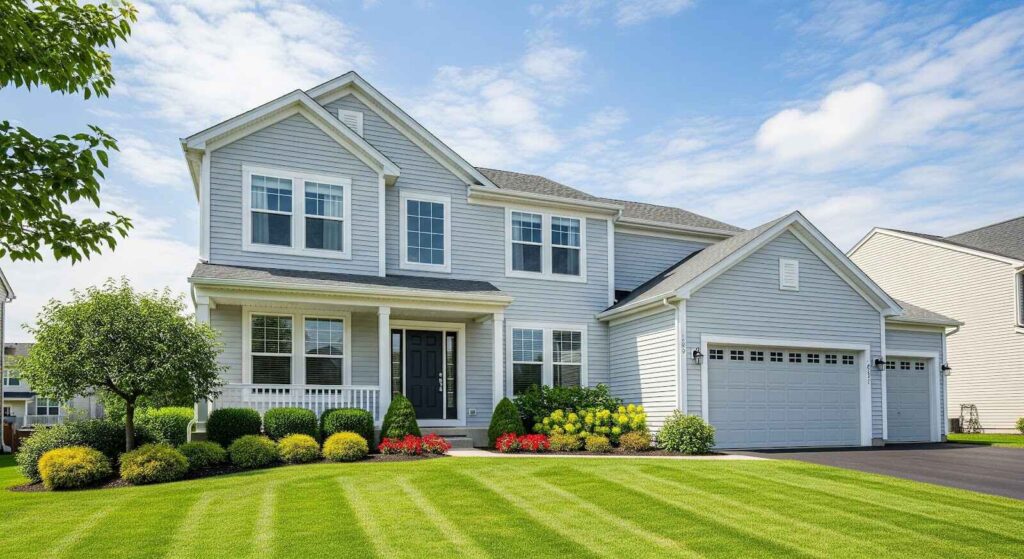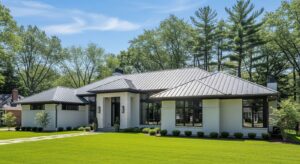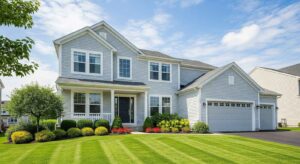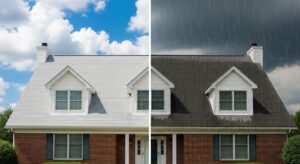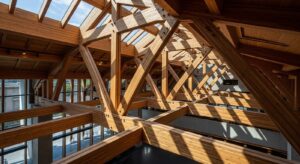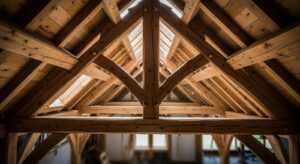Vinyl siding has become America’s most popular exterior cladding choice, and for good reason. It offers an unbeatable combination of affordability, durability, and low maintenance that appeals to millions of homeowners. But understanding its true lifespan – and how to maximize it – can save you thousands of dollars and countless headaches down the road.
In this comprehensive guide, we’ll dive deep into everything you need to know about vinyl siding longevity, from expected lifespans to maintenance secrets that can extend your investment for decades.
Understanding Vinyl Siding Lifespan: The Real Numbers
So, how long does vinyl siding last in real-world conditions? The answer might surprise you with its range and variability.
High-quality vinyl siding typically lasts 20 to 40 years, with many installations reaching or exceeding the upper end of this range when properly maintained. However, this lifespan depends on several critical factors that we’ll explore throughout this guide.
Premium vinyl siding from reputable manufacturers often comes with warranties ranging from 25 to 50 years, giving you a good indication of expected performance. Some manufacturers even offer lifetime warranties on their top-tier products, though these usually come with specific conditions and limitations.
Factors That Determine Vinyl Siding Longevity
The actual lifespan of your vinyl siding depends on multiple interconnected factors:
Climate and Weather Exposure Your local climate plays a massive role in determining how long your vinyl siding will last. Homes in moderate climates with minimal temperature fluctuations often see their siding last 35-40 years or more. However, areas with extreme temperature swings, intense UV exposure, or frequent severe weather may experience shorter lifespans of 20-25 years.
Installation Quality Professional installation versus DIY work can mean the difference between siding that lasts two decades versus four decades. Proper installation includes adequate expansion gaps, correct fastening techniques, and appropriate underlayment – all crucial for long-term performance.
Siding Quality and Thickness Not all vinyl siding is created equal. Premium siding typically measures 0.044 to 0.055 inches thick, while budget options may be as thin as 0.035 inches. Thicker siding generally provides better durability and longevity, making it worth the additional cost vinyl siding investment upfront.
Maintenance Consistency Regular cleaning and maintenance can significantly extend your siding’s lifespan. Homes with consistent care often see their siding lasting well beyond the expected range.
Vinyl Siding vs. Other Materials: Lifespan Comparison
When considering exterior cladding options, it’s helpful to understand how vinyl stacks up against alternatives like fiber cement in terms of longevity and value.
Hardie Board vs Vinyl Siding: Durability Showdown
The Hardie board vs vinyl siding debate often centers on longevity expectations. Fiber cement siding (like James Hardie) typically lasts 30-50 years, giving it a slight edge over standard vinyl siding. However, this comparison requires context:
Hardie Board Advantages:
- Longer average lifespan (30-50 years)
- Superior fire resistance
- Better performance in extreme weather
- Maintains appearance longer without fading
Vinyl Siding Advantages:
- Lower upfront and maintenance costs
- Easier DIY repairs
- Better insulation properties
- No painting required ever
Wood Siding Comparison Traditional wood siding lasts 15-25 years with proper maintenance, making vinyl a more durable long-term choice. Wood requires regular painting, staining, and treatment to prevent rot and insect damage.
Aluminum Siding Comparison Aluminum siding can last 25-40 years but is prone to denting and scratching. It also requires periodic painting, unlike vinyl which maintains its color throughout its lifespan.
Signs It’s Time to Replace Your Vinyl Siding
Recognizing when your vinyl siding has reached the end of its useful life helps you plan for replacement before problems become severe.
Visual Indicators of Aging Siding
Severe Fading and Discoloration While some fading is normal over decades, severe color changes that make your home look worn and dated indicate it’s time for replacement. Modern vinyl siding with improved UV protection fades much less than older formulations.
Cracking and Splitting Small cracks can often be repaired, but widespread cracking throughout multiple panels suggests the material has become brittle with age. This typically occurs after 25-30 years in harsh climates.
Warping and Buckling Panels that no longer lie flat against your home’s exterior indicate either installation problems or material failure. This issue often develops around the 20-25 year mark if the original installation was subpar.
Increased Energy Bills If your heating and cooling costs have crept up significantly, aging siding with reduced insulation properties might be the culprit. Newer siding often includes improved insulation backing.
Performance Issues
Frequent Repair Needs If you’re calling contractors multiple times per year for siding repairs, replacement becomes more economical than continuous patch work.
Moisture Problems Water infiltration behind siding can cause serious structural damage. If you notice interior moisture issues or exterior water stains, investigate immediately.
Essential Maintenance Tips to Maximize Lifespan
Proper maintenance can easily add 10-15 years to your vinyl siding’s life, making these practices incredibly valuable investments of time and effort.
Regular Cleaning Protocol
Annual Deep Cleaning Use a good vinyl siding cleaner or create your own solution with warm water, mild detergent, and a small amount of bleach for mildew prevention. Power washing is acceptable but use low pressure (under 1,500 PSI) and spray at a downward angle to prevent water infiltration.
Monthly Visual Inspections Walk around your home monthly to check for loose panels, cracks, or other damage. Early detection prevents small problems from becoming major repairs.
Seasonal Maintenance Tasks
- Spring: Check for winter damage and clean thoroughly
- Summer: Inspect for UV damage and ensure proper ventilation
- Fall: Clear debris from behind panels and check caulking
- Winter: Remove ice dams promptly to prevent damage
Preventive Care Strategies
Landscaping Considerations Keep vegetation trimmed back at least 12 inches from siding to prevent moisture retention and scratching. This simple step prevents many common siding problems.
Gutter Maintenance Properly functioning gutters prevent water from cascading over siding, reducing moisture-related deterioration. Clean gutters seasonally and repair promptly.
Caulk Inspection and Replacement Check and replace caulking around windows, doors, and trim annually. This prevents moisture infiltration that can damage both siding and underlying structure.
Cost Considerations: Investment vs. Longevity
Understanding the true cost vinyl siding over its lifetime helps you make informed decisions about materials and maintenance.
Initial Investment Analysis
Premium vinyl siding costs $3-8 per square foot installed, while budget options range from $2-4 per square foot. However, the higher upfront investment often pays dividends in longevity and reduced maintenance needs.
Calculating Lifetime Value Consider a home requiring 2,000 square feet of siding:
- Budget vinyl ($6,000 total, 20-year lifespan): $300 per year
- Premium vinyl ($12,000 total, 35-year lifespan): $343 per year
- The premium option provides 75% more lifespan for only 14% higher annual cost
Maintenance Cost Projections
Annual maintenance typically costs $200-500 for professional cleaning and minor repairs. This investment can extend siding life by 25-40%, making it one of the best returns on home improvement spending.
Different Siding Styles and Their Longevity
The style of vinyl siding you choose can impact both aesthetics and lifespan, making this an important consideration during selection.
Popular Siding Styles and Durability
Traditional Horizontal Lap Siding The most common style, horizontal siding generally lasts the full expected lifespan when properly installed. Its simple design minimizes potential failure points.
Vertical Board and Batten This style can last just as long as horizontal siding but requires more attention to water drainage details during installation.
Shake and Shingle Styles Textured vinyl that mimics cedar shakes often has slightly shorter lifespans due to increased surface area exposed to weather, typically lasting 20-30 years.
Mixed Material Applications Combining different siding styles or materials like siding and stucco can create stunning exteriors but requires careful attention to transition details and differential expansion rates.
Environmental Factors Affecting Siding Lifespan
Your local environment significantly impacts how long vinyl siding will last, making climate consideration crucial for realistic expectations.
Climate Impact Assessment
Coastal Environments Salt air accelerates material degradation, potentially reducing lifespan by 5-10 years. Regular cleaning becomes even more critical in coastal areas.
Desert Climates Intense UV exposure and extreme temperature swings can cause brittleness and fading. High-quality UV-resistant siding is essential in these environments.
Northern Climates Freeze-thaw cycles can cause expansion and contraction stress, but proper installation with adequate expansion gaps mitigates most issues.
Humid Subtropical Climates High humidity and frequent storms require excellent drainage and ventilation behind siding to prevent moisture problems.
Frequently Asked Questions
Q: How long does vinyl siding last compared to other materials? A: Vinyl siding typically lasts 20-40 years, which is comparable to aluminum siding and longer than wood siding (15-25 years) but shorter than fiber cement siding (30-50 years).
Q: Can I extend my vinyl siding’s lifespan? A: Yes, regular cleaning, prompt repairs, proper landscaping, and annual inspections can add 10-15 years to your siding’s life.
Q: What’s the most common cause of premature vinyl siding failure? A: Poor installation accounts for most early failures, followed by lack of maintenance and extreme weather exposure.
Q: How do I know if my vinyl siding needs replacement? A: Look for widespread cracking, severe fading, warping, frequent repair needs, or moisture infiltration issues.
Q: Is premium vinyl siding worth the extra cost? A: Premium siding typically lasts 10-15 years longer than budget options, making it cost-effective over the long term despite higher upfront costs.
Q: How often should I clean vinyl siding? A: Annual deep cleaning with monthly visual inspections provides optimal maintenance. Use a good vinyl siding cleaner or mild detergent solution.
Conclusion: Maximizing Your Vinyl Siding Investment
Understanding how long vinyl siding lasts empowers you to make informed decisions about your home’s exterior. With proper selection, installation, and maintenance, vinyl siding can protect and beautify your home for 30-40 years or more, providing excellent long-term value.
The key takeaways for maximizing your investment include choosing quality materials, ensuring professional installation, maintaining consistent care, and addressing issues promptly. While the cost vinyl siding varies significantly, investing in premium materials and proper maintenance pays dividends over decades.
Whether you’re comparing Hardie board vs vinyl siding options or researching the best good vinyl siding cleaner, remember that longevity comes from the combination of quality materials and consistent care. Different siding styles and applications like siding and stucco combinations can achieve decades of performance with proper planning.
Ready to make the best decision for your home’s exterior? Contact local siding professionals for personalized assessments and quotes. They can evaluate your specific climate conditions, home structure, and aesthetic preferences to recommend the optimal siding solution for maximum longevity and value.
Your home deserves protection that lasts – make sure you’re getting the most from every dollar invested in your exterior.

